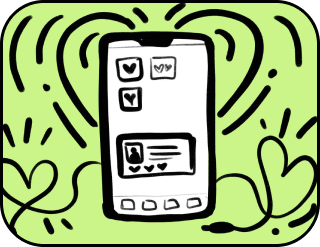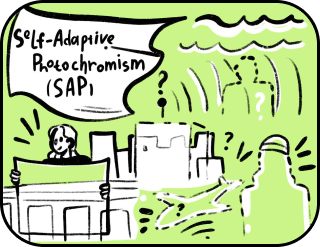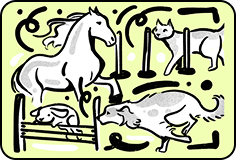Category: Life technologies
Technologies that make us happier
“Happiness exists — it simply cannot not exist”
A track by DJ Groove
“They cannot live without me!” Happiness beamed, breaking into a smile as it opened the gates of Seventh Heaven for yet another lucky visitor. “Everyone is in active pursuit. Recipes for joy, otherworldly love, miracle buttons. Any means will do, as long as they get here. It is a good thing some manage to succeed. Not everyone, of course. And never immediately. The gates stay open. I wonder, what exactly are they expecting from me? A fireworks display of positive emotions? An abrupt end to suffering? Or am I supposed to hover somewhere off in the distant future, dressed as the Firebird, so they have something to look forward to tomorrow? By the way, for some reason, there are still empty seats in Seventh Heaven today. I refuse to believe anyone would consciously choose not to meet me. Seems like they got lost in the Forest of Superstition and Disbelief or sank into the Swamp of Laziness. Well, I suppose I shall have to sacrifice my tail. Am I the Firebird or am I not? That is the question.”
While Happiness was lost in philosophical musings, we were busy gathering the feathers it had shed — becoming a little happier with every find. And now, we are sharing. Generously. No, not happiness itself. Everyone has their own. But two possible answers to the question: “How does one become happy?”
You have to learn — if you truly want to, but for some reason just cannot. Grab a textbook on felicitatology and start gnawing on the granite rock of happiness science. Sure, it might not be the quickest road to Seventh Heaven. There are ways to take a shortcut, though. Pluck a few bills off the homegrown money tree and hand them over to a coach for a “Happiness Marathon.” It works, as long as you are genuinely aiming for a positive result. As questionable as our mischievous little piece of advice might seem, positive psychology actually backs this method. Its founding father, Martin Seligman (USA), developed a technique called “learned optimism.”
Diligent students, by shifting their attitude from habitual negativity to a conscious, motivated plus, take the remote control of their lives into their own hands and deliberately choose a program of success. Optimism can be “acquired” by honing the skill of reacting to unpleasant things in a thoughtful way — picking out counterarguments to the all-too-obvious negative conclusions from yet another sad little story.
The goal? To find joy and motivation, to turn the downward curve of life back uphill.
And the metamorphosis of consciousness looks something like this:
- Another mountain of dirty dishes! Whoever washes them is just wasting their time. (initial state)
- Agatha Christie, who suffered from this same boring chore just like me, used to channel her irritation into brilliant detective plots. (applying the skill of optimistic thinking)
- Yes! I will wash the mugs and get to creating. I have so many ideas swirling in my head — one author’s sheet will not be enough to hold them all. (halfway to happiness)
By the time their studies are over, the freshly minted optimist truly believes in the best and burns with the desire to find a way out of any dead end. With that kind of attitude, a clear route to Seventh Heaven is bound to be charted — provided, of course, that optimism does not cross the line into sheer recklessness. It is important that life’s striped zebra still be visible through those rose-colored glasses.
Do you lack a guarantee that your inner navigator will not let you down? Easy. Take a lucky charm along for the ride. Horseshoes, acorns, four-leaf clovers — humanity has come up with a whole collection of pocket-sized happiness batteries.
Or you could make things a bit more interesting by paying a visit to a stationary wish-granting figure. All you need to do is stroll down any tourist trail. Sooner or later, you will come across a “lucky” monument — and if you touch the right spot, you might just get a little something in return. In St. Petersburg, you are supposed to stroke the griffin’s head near the Academy of Arts. In Urjupinsk, people rub the nose of a goat statue. In Kostroma, the ring held by a jeweler sculpture shines from the thousands of hands that have polished it over time.
You can expand the surface area of your good-luck rubbings and measure your path to happiness in air miles. Lucky statues are scattered all over the globe. One of the largest — the “Charging Bull” — stands in New York. Its nose, horns, and, well, a few other parts gleam like a mirror.
And for those who have already worn out their palms chasing happiness, there is a more romantic way of getting closer to monumental art — through kisses. It is a tradition to kiss the human-sized panels that fence in Oscar Wilde’s grave in Paris. This curious ritual is said to bring extraordinary love into an ordinary life.
If all the tickets for the “Happiness Route: St. Petersburg–Urjupinsk–Kostroma” have already been snatched up, the weather is non-flying, and there is no friendly horse nearby willing to part with its horseshoe, just turn something within arm’s reach into your personal good-luck charm. How? By sheer force of will.
The generation of your happiness does not take place in a clover field. Conduct the whole process in your mind!
With a flick of your inner conductor’s baton, pick the fellow travelers who will make for the right company on your way to the final destination. The rule is simple: the more, the better. A prince on a white horse, loving parents, a tactful colleague, a childhood friend — they all pass the casting automatically. A pass to Seventh Heaven is granted to those who have managed to build love, never lost the road back to their parents’ home, found their place in a harmonious team, and proven their friendship well beyond the festive dinner table.
This conclusion was reached by researchers from the longest-running psychological study in history — The Harvard Study of Adult Development. Since 1938, psychologists have been tracking real-life manifestations of happiness in the lives of their subjects. The comforting results were compiled by university professor Robert Waldinger in his book “The Good Life”: happiness exists, and it takes root in warm, lasting relationships. The number of kindred spirits in one’s life matters too. In other words, paradise in a hut with your sweetheart is far less likely than a little slice of heaven in a shared apartment with soulful neighbors.
There is one happy exception to the rule — loners who have managed to organize their lives so well that they feel perfectly fine on a deserted island. The method of building happiness around someone else’s presence is better suited for those who drink champagne — risking at any moment to be left with nothing but a shattered trough, courtesy of unexpected betrayals or sudden departures.
Tested all the practical solutions but happiness is still nowhere to be found? Well, maybe you picked the wrong acorn. Or perhaps your so-called soulmate was never meant to fit your family puzzle in the first place. Time to file a complaint! Straight to the Ministry of Happiness — if you happen to live somewhere near the Himalayas. In the Kingdom of Bhutan, the level of Gross National Happiness is officially measured.
Though, to be fair, even a formal complaint there is no guarantee of a fast-track ticket to Seventh Heaven. These attempts to regulate the collective mood from the top down are a touching gesture of care for the citizens, but when it comes to matters of the heart, the state’s grip slips. It is simply too personal.
And by the way — in the latest edition of the World Happiness Report compiled by Columbia University, the kingdom did not even crack the top ten happiest countries, no matter how hard it tried.
Still, no reason to hang your head, throw in the towel, or hand the horseshoe back to the friendly horse. Yes, the road to Happiness is full of stumbles. And you will trip, more than once. Feeling tired? Well then — take the elevator. Scientists, without much hope of running into the Firebird themselves, suggest a few universal button-pressing ways to reach the desired state.
Shall we give them a try?
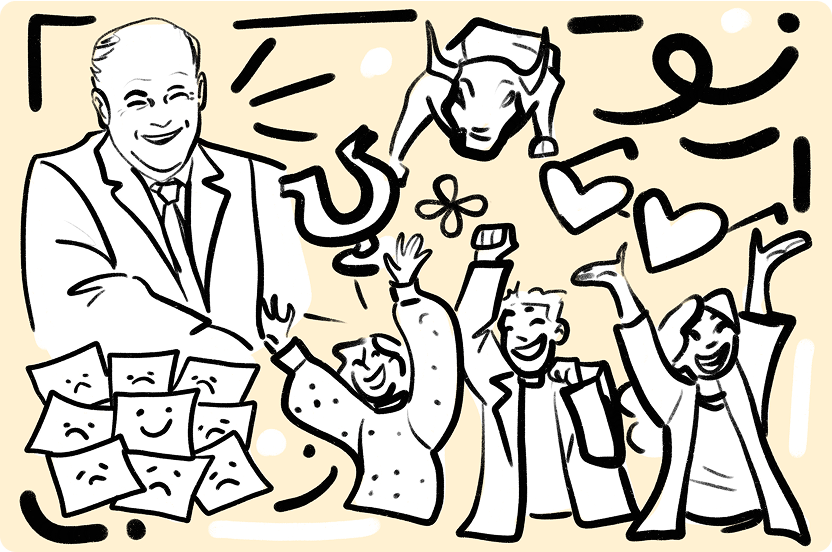
Countless apps now promise turnkey happiness, designed to both motivate and — more importantly — control your chaotic zigzag toward the ultimate goal. At the core of these technologies lies a simple truth that became public property nearly two centuries ago, thanks to Alexander Griboedov.
A brief theatrical pause is in order. Let’s revisit a famous scene from “Woe from Wit”:
Liza:
…Look at the clock, glance out the window:
The streets have long been filled with people;
In the house — footsteps, sweeping, bustling.
Sophia:
The happy never watch the clock.
A genius strategy, time-tested and still relevant: find something you truly love to do, something that completely absorbs you, leaving no room for the things that get in the way of living.
Modern apps built around this principle offer several types of activities:
- Diagnose and measure.For example, HappyHero assesses your current happiness level, tracks the factors behind negative emotions (based on heart rate monitoring), and follows the dynamics of your mood improvement over time.
- Meditate, breathe, and sleep. Ilya Moskvin, the creator of the Serotonin app, went in search of inspiration through university lectures and spiritual hotspots all over the world, including a stop in the Kingdom of Bhutan. His project’s concept is built around a neurophysiological approach to meditation, aimed at developing concentration and clearing out mental clutter. It features a visual breathing trainer, a tactile mode, and even lulls users to sleep with bedtime stories, white noise, and soothing soundscapes. A healthy, stress-free sleep, in turn, boosts production of that very same serotonin — the “happiness in the moment” hormone.
- Reflect and visualize. The Be Happy app keeps its users motivated with daily quotes and witty aphorisms. To help you grasp the subtle art of joyful living, it offers stylized designs for your screen widgets. A party every day? Well — sadly — no, especially if you’re enthusiastically celebrating your own private Groundhog Day. A habit, even one graciously bestowed from above, is no substitute for actual happiness. Allow me to disagree with you here, dear Alexander Sergeyevich. Of course, the sun of Russian poetry could afford to radiate such optimism. With a flick of his pen, Alexander Pushkin gives Madame Larina in Eugene Onegin a tidy little happiness in the form of her household routines — never mind the loveless marriage. But alas, your fate isn’t in the hands of a cheerful poet. Routine alone won’t get you to the Seventh Heaven. The trouble is, getting used to what once delighted you inevitably dulls the glow. This phenomenon was neatly defined by American psychologist Donald Thomas Campbell as the hedonic treadmill. You can absolutely get breathless with happiness — but not forever, if you’re stuck in a loop of monotony. Your reasons to jump for joy should come in a rich, varied assortment, vastly outnumbering your army of one-size-fits-all apps. Besides, applying a universal yardstick to deeply personal emotions — or trying to distract a person from their own empty spaces with Big Questions — is, frankly, a shaky plan. You might as well enroll in a virtual dance school: count the likes on your pointe-shoe selfies, learn a new move each day. The spin-off practices and motivational pep talks about taking the stage might fill your emotional void for a while. But don’t expect your own personal Swan Lake to materialize. Something’s missing. Chemistry.
The chemical nature of happiness stopped being a secret for the chosen few long ago. The famous quartet of hormones — dopamine, oxytocin, serotonin, endorphins — is responsible for express delivery to Seventh Heaven. The idea of tweaking your hormonal balance with a happy diet lies at the heart of the Mood food trend. Yes, a sugary dessert really can make the road to happiness a little smoother. Sugar triggers dopamine production, which brings that pleasant rush of satisfaction.
But ultimately — whether or not you choose to be happy is entirely up to you. Sweet treat or no sweet treat, is this where you place your final full stop… or is this the start of the party? A banana might boost your serotonin, sure — but it won’t lift your spirits quite like a banana soufflé cake with “I’m yours” scrawled across it in chocolate. Fun fact: in that case, the serotonin rush would get a little backup from an oxytocin spike — the “cuddle hormone” — triggered by the sweet anticipation of intimacy.
Although, none of these hormonal festivities will kick off unless the cake-eater genuinely believes that the sitcom “Happy Together” was based on a true story.
Soon enough, people suffering from depression might get force-fed happiness whether they like it or not — thanks to neurotechnology. According to The Guardian, the American company Forest Neurotech is currently testing a device called Forest 1. This futuristic contraption allows information to pass directly between your brain and an electronic gadget. The plan? To implant the device inside the skull and create 3D maps of brain activity. During depression therapy, ultrasound waves will be used to tune up your neurons like a slightly out-of-whack piano.
Now, personally — I wouldn’t be rushing to the queue for a shiny new neurochip when it finally hits the market. Something tells me the side effects of being remotely managed might be a tad unsettling. But hey, let’s not get ourselves worked up ahead of time!
Meanwhile, our slightly scruffy, tail-worn Happiness sat pensively high above, dangling its legs from the Seventh Heaven balcony. Below, a familiar scene: crowds of people scurried about, convinced life was passing them by.
“I’ll knock on the first door I find,” Happiness muttered. “If they don’t believe me, they won’t open. Only misery gets a free pass through the gates. Honestly, it’s insulting. I’m done with these solo attempts. The only thing that ever drops from the sky is bad luck. If anyone wants me — they can climb up here, or catch the elevator. Whatever works for them. Personal choice. I’ll be waiting. For everyone.”
Happy end.
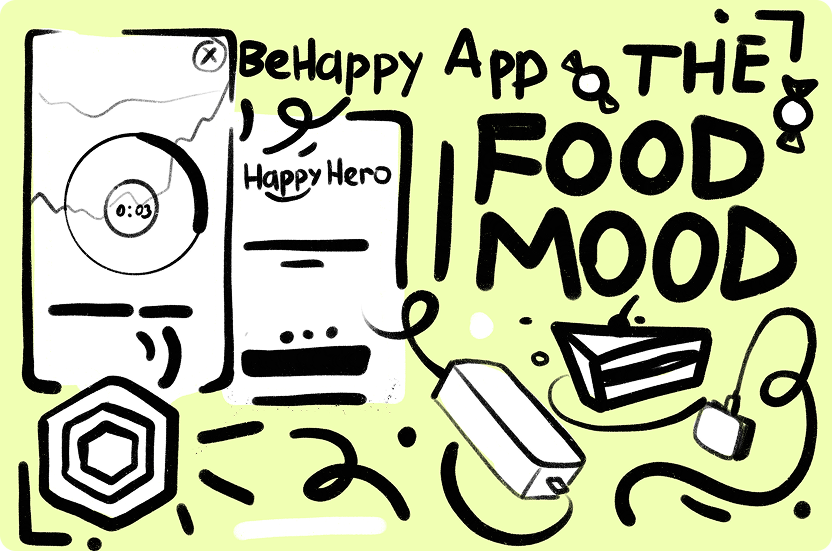
Scientists have decoded the human genome. We’ve decoded the genome of interest. Only pure science and facts.
Thank you!


